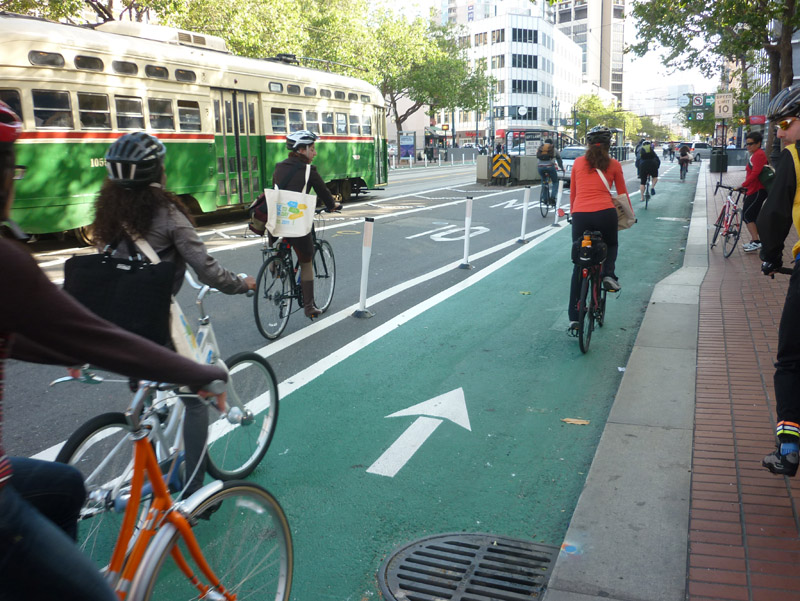This innocuous-sounding quote from the recent SF Chronicle article Transportation boosts cost of living in suburbs very poignantly describes not only the structural problems of suburban life but gets to the core of the absurdity and unsustainability of our modern fossil-fueled lives.
It’s from Scott Bernstein, President of Chicago’s Center for Neighborhood Technology, whose organization just released The Housing + Transportation Affordability Index, a study that adds transportation costs to the usual measure of affordability — housing prices.
Here’s the full quote that I think is worth being made into a refrigerator magnet for anyone thinking about moving, whether you’re buying or renting:
“You think you’re buying a cheap house 30 miles out,” he said, “but it’s 10 o’clock at night, and you need a gallon of milk. You have to get in your car, drive out of your subdivision down a two-lane road, get on the freeway and drive 10 miles. You just spent a gallon of gas to get a gallon of milk.”
boldface mine

While the issue of access by proximity as a key principle for organizing human civilization so it can survive on and live in harmony with planet Earth only resonates with some of us, the more immediate effect of our decisions on our pocketbook is something that everyone can and should relate to.
In light of over $4 a gallon gas prices, it seems like a good opportunity to reevaluate the conventional wisdom that living in the suburbs is cheaper than living in the city.
Often, Bernstein said, people in search of more affordable housing will head to the distant suburbs where real estate is cheaper but won’t always consider that transportation is costlier because driving distances are longer and public transportation is often unavailable.
While transportation costs may not be a factor in a world of $1 per gallon gasoline, it becomes a serious factor in a $4 or $5 per gallon of gasoline world. The point of the survey that is based on figures from the Census’ American Communities Survey and includes about 89 percent of the nation’s population, is to include transportation when considering housing affordability.
The study allows visitors to the center’s website, www.cnt.org, to see and compare the costs in 180,000 neighborhoods. Not surprisingly, denser communities with access to public transportation fare better than far-flung suburbs.
Affordability is defined as a combined housing and transportation figure below 45 percent. Taking the Bay Area as an example, the study comes up with these very interesting, though to me not surprising numbers.
San Francisco households spend 39.5 percent of the average income in the region on housing and transportation compared to 41 percent in Oakland, 43 percent in Berkeley, 50 percent in San Rafael, 51 percent in Antioch and 59.1 percent in Brentwood.
In other words, if you’re making 40k a year and you’re living in SF, Oakland, or Berkeley, you’re spending about 16k of that income on housing and transportation, whereas if you’re living in Brentwood or some of the other far out bedroom communities, you’re spending 24k of your hard-earned money on housing and commuting. Aside from all other factors that may lead someone to prefer living in the city or the suburbs, from an economic perspective, denser city living clearly has the edge.
Suburban Transportation…
City Transportation…
The authors of the study are in no way demonizing the suburbs, but their goal is “to provide planners, decision makers and everyday folks with information about the true costs of choosing where to live.” Obviously, not everyone who lives in the suburbs commutes to far away jobs and not everyone who lives in a city can walk or take public transit to their jobs, but the average difference in affordability cited here is huge. Also, for some people the bigger house in the suburbs may be worth the considerably higher cost of transportation, not just the $’s but the time spent on the road.
What this does say though is that living in the suburbs comes with a price tag that is often ignored when considering a move. And I’m not even talking about the costs to the only planet we have.
Find your own Housing & Transportation Affordability.
Find your Walkscore.










It’s interesting that when qualifying for a home loan, the costs of transportation to work aren’t included while, of course, the income from working is the most important factor. Counted against the borrower are all fixed payments (home loan and other loan payments, credit card payments, child support, etc.) and, years ago when I worked in the field, all of those payments couldn’t add up to more than about 30% of the borrower’s gross income.
In reality, it is our net income that we live on, which is directly impacted by the costs of transportation. Great point by Bernstein. Thanks for writing about this, Sven.
In a way these real estate practices are still dating to a time when gas and energy were so cheap and such a negligible part of people’s budget that it literally didn’t matter in your choice of home and location. I do think those times are rapidly coming to an end and realtors, banks and home buyers will have to consider those rising costs more and more in their decisions. Transportation and distance from your work will continue to be an increasing factor, as well as the energy efficiency of the house/condo. For example, the difference between heating a big and poorly insulated house and heating a smaller, well designed building are already enormous, but once you add rising costs of gas and electricity it really becomes a factor in the overall cost of living.
It’ll be interesting to see how the market will adjust to these new realities, but my hunch is it won’t be kind to those who will seek to continue to externalize these costs. Denial only gets you so far until reality kicks in.
Thanks for reading and chiming in, Pam.
[…] Blog March 6, 2012 Survey: More Income Used in Transportation Costs 10 News San Diego March 5, 2012 You Just Spent a Gallon of Gas to get a Gallon of Milk A World of Words Blog March 5, 2012 Center Says Portland Transportation Costs About Average The […]
Very happy to find your blog. So many important questions to consider here when thinking of where and how to live. I don’t think many suburbanite’s truly realize “the core of the absurdity and unsustainability of our modern fossil-fueled lives.” When I mention it people often look at me like I’m crazy. A friend said recently how wonderful it is that, from the suburbs, it only takes an hour or so to drive to the city for work and only an hour or so to drive to the rural areas for a getaway. All of those hours of fuel add up and the earth really is paying the price. We need to envision new possibilities. Good to see that more communities are learning that the time is now to make real changes.
It’s really amazing how so many people live in a complete bubble, no matter where they are. To them, the food they eat originates in the store where they buy it and the gas they pump magically appears at the station. I guess it really is our collective fault that we have made everything so easily accessible without showing any of the steps and processes to extract and distribute massive amounts of energy that took millions of years to form in a matter of decades. It’s hard for me to fathom how nonchalant people seem to be about this serious problem of overconsumption, especially people with children.
Thanks for stopping by, I look forward to exchanges from suburbia to urbia!
Sven, this is excellent! Just the type of info I’ve been looking for.
So sorry I missed you in Vancouver!! I really would have loved to get together. If you come here again, please let me know ahead of time.
Do you know, is there a study of this type for Canada?
I’m not sure about it Lark, but I have a feeling there is. Bummed to have missed you but I was so busy running around, next time I hope I have more time to just hang out and enjoy the city. I’ll definitely let you know.